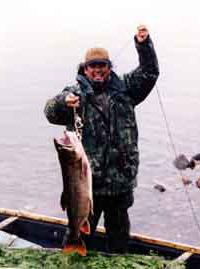Strategies to Create New Words
All human languages use certain common strategies to create new words:
- borrowing from another language
- giving a new meaning to existing words
- creating new words using the rules of the language
Strategy One: Borrowing
1. Borrowing a word from another language
Using or borrowing a word from another language is a common way of finding new words when a language needs them. The words are usually borrowed from the language and culture which introduces the new item or idea. In Cree, the words which have been borrowed are mainly nouns which are names for things, often items of food and clothing or new technology.
Older borrowed words are integrated into the language and have a very Cree pronunciation. New or recently borrowed words have a more English or French pronunciation and include verbs as well as nouns. All borrowed words take Cree inflection. For example:
| ᓂᑲᒻᐱᔫᑎᕆᒥᔥ |  |
ni-computer-imish | my laptop (lit. my little computer) |
| ᔔᑳᐤ |  |
shuukaau | sugar |
| ᑏ |  |
tii | tea |
| ᑏᐧᐹᑦ |  |
tiipwaat | teapot |
| ᒫᒌᔅ |  |
maachiis | matches |
| ᐧᑳᐲ |  |
kwaapii | coffee |
| ᐯᐹᐤ |  |
pepaau | pepper |
| ᐸᑦ |  |
pat | butter |
| ᑲᐸᑦ |  |
kapat | cupboard |
| ᐸᑌᑎᔅ |  |
patetis | potatoes (patates) |
| ᐧᐹᑲᑦ |  |
pwaakat | |
| ᐯᑎᑯᑦ |  |
petikut | petticoat |
| ᒉᑲᑦ |  |
chekat | jacket |
| ᒪᓛᔅ |  |
malaasis | molasses |
| ᒥᓂᑯᔥ |  |
minikush | minute |
| ᒫᐦᑮ |  |
maahkii | marquee |
| ᐸᐧᓛᒡ |  |
palwaach | badge |
| ᓕᐱᓐ |  |
lipin | ribbon |
| ᓓᔅ |  |
les | lace |
| ᑭᒋᓐ |  |
kichin | kitchen |
| ᐲᓐᑰ |  |
piinkuu | bingo |
| ᐲᓂᓴᒡ |  |
piinisach | beans |
| ᐴᑎᓐ |  |
puutin | pudding |
| ᐧᐋᒡ |  |
waach | watch |
| ᐧᑳᑦ |  |
kwaat | coat |
| ᐧᐹᐦᒡ |  |
pwaahch | porch |
| ᐹᓂᑮᒃ |  |
paanikiik | pancake |
| ᐧᔖᓪ / ᐧᔖᓐ |  |
shwaan | shawl |
| ᐋᐦᐋᔅ |  |
aahaas | horse |
| ᒑᒻ |  |
chaam | jam |
| ᐧᒑᑲᓚᑦ |  |
chwaakalat | chocolate |
| ᓰᐅᑏᔅ |  |
siiutiis | sweets |
| ᔅᐯᑦ |  |
spet | spade |
| ᐁᓐᒋᓪ |  |
enchil | angel |
| ᔅᑮᑑ |  |
skiituu | skidoo |
| ᔅᑯᓪ |  |
skuul | school |
| ᓰᐹᐃ |  |
shiipaai | cipaille | dumpling |
| ᒦᓅᔥ |  |
miinuush | minouche | cat |
| ᑳᓘ |  |
kaaluu | carreaux | card |
| ᐴᑕᐃ |  |
puutai | bouteille | bottle |
| ᑑᐲᔅ |  |
tuupiis | autobus | bus |
| ᑌᑲᓓᑉ |  |
tekalep | des crêpes | pancake, crepe |
The pronunciation of new borrowed words is closer to the original English or French pronunciation because people now are bilingual or trilingual. This is especially true of names for people which are borrowed from English and French with their English and French pronunciation, even if they are being written in syllabics.
Certain classes of words are commonly used with the English pronunciation while speaking Cree. These are the words for numbers, expressions of time (days, months) and colours.
2. Borrowing the Translation only
Another way of borrowing is to use the ideas in the dominant language but translate them literally into Cree, as for example when chairman is translated as *ᑌᐦᑕᐳᐧᐃᓈᐯᐤ *tehtapuwinaapeu chair+man or as ᑌᐦᑕᐳᐧᐃᓅᒋᒫᐤ tehtapuwinuuchimaau chair+boss, instead of using the Cree word, ᑳᓃᑳᓇᐱᔥᑕᐦᒃ kaaniikaanapishtahk. Literally translated words exist because of language contact and bilingualism. This is not considered a good way to make new Cree words.
Strategy Two: Giving a New Meaning to an Existing Word
This process is found in all languages of the world. There is usually an element of meaning that is common to the old usage and the new usage of the word. For example, apui the paddle and apui the propeller have in common a certain shape (the shape of a paddle) and a function (moving something forward). When a word has two meanings which have a common element we speak of polysemy.
| Original Meaning | New Meaning | |||
| ᐊᐳᐃ |  |
apui | paddle | propeller |
| ᐃᔥᑯᑌᐤ |  |
ishkuteu | fire (ni) | battery (na), sparkplugs |
| ᒫᑎᔅ |  |
maatis | flint | sparkplug (na, Waswanipi) |
| ᐅᔥᑲᔒ |  |
ushkashii | nail, claw | skidoo track |
| ᐊᐦᐄᐲ |  |
ahiipii | net | net for hockey, basketball and other games, lamp mantle (Waskaganish) |
| ᐅᑕᒋᔒ |  |
utachishii | guts | hose, extension cord |
Strategy Three: Using the Rules of the Language
Neologism is the art of making new words using the rules of the language. Words live and die. Words to talk about bush life are dying today in Cree because less people live in this reality. On the other hand, words that reflect the modern life are created everyday by Cree speakers. See the terminology forum.
| ᒀᔥᒀᔥᑫᐸᔨᐦᐆᐙᑲᓐ |  |
kwaashkwaashkwepayihuuwaakan (ni) | jolly jumper |
| ᑳᐧᑳᔥᐧᑳᐧᑫᐸᐦᑖᑦ |  |
kaakwaashkwaashkwepahtaat (nap) | kangaroo |
In Cree, a word is made up of many small parts and it is important to understand what these parts are and how they combine to understand how new word creation can happen in Cree. See: Structure of Cree words.
The parts of a word: ᐄᑖᐯᑲᒨ iitaapekamuu it (string-like) stretches from here to there.
| iit | aapek | amu | -u |
| so | string-like | stretch | 3rd persons/he |
| INITIAL | MEDIAL | FINAL | Personal suffix |
| STEM | INFLECTION | ||
 Grammar
Grammar